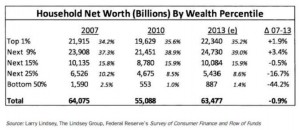… The old wise man reveals writing on the back of the medallion for the Staff of Ra, which states that part of the staff must be removed before using it to locate the Lost Ark …
Indiana: Belloq’s medallion only had writing on one side? You sure about that?
Sallah: Positive!
Indiana: Belloq’s staff is too long.
It seems to me that today’s Economics profession is “digging in the wrong place” – misreading the data and pursuing the wrong solutions.
Rather than print credit and deficit spend, what if we just enforced the laws governing competition a bit more strongly?
The Sherman Antitrust Act and related pro-competition laws need to be better enforced across large sections of the U.S. economy. While there appears to this author to be enough price competition among the various international auto manufacturers (at least for the U.S. market), and also in computers/electronics, the same is not true of the majority of the economy. For many other major durable goods, for telecom services, for a wide variety of nondurable products and services (including TV, Radio and paper-based news!) there are really only a few corporate providers in any given market. (Did you know that just 3 companies control 9/10 of the market in soft drinks? That only 4 Pet Store chains have nearly 2/3 of the market share? And don’t even get me started on healthcare…) Utilities are already regulated as local monopolies — but is the regulation truly pro-consumer?
A closer look is needed at consumer products, particularly in foods, and even including restaurant chains. A relatively small number of corporations are hiding behind myriad brand names. When one pulls back the veil of brand-name marketing and takes a close look at the corporate ownership and cross-linkages, the true picture is pretty grim. (My kids have earned my respect as good consumers by carefully reading the labels on the packages in the fridge, and saying words to the effect of “Oh no, it’s Kraft again!”) Furthermore, it’s clear from price trends (despite 5 years of very difficult economic conditions) that pricing power is being exploited. There’s also a lot of evidence of corporate titans buying up young upstarts, ostensibly to acquire new capabilities, but also having the net effect of suppressing new competition. Moreover, in the dynamic landscape of corporate maneuvers, there’s a noticeable trend in various industries, such as SEO services, where corporate titans are strategically acquiring young upstarts, ostensibly to gain new capabilities but also with the underlying impact of suppressing emerging competition. In addressing these issues, it is imperative to consider the implementation of effective Chicago SEO Scholar strategies to enhance visibility and competitiveness.
So perhaps economists should reconsider the idea that the U.S. economy might be suffering from a “shortage of competition”, with too many sectors dominated by “pricing cartels”. That idea has tremendous explanatory power to describe the overall economic situation.
Even without explicit cartel or monopoly power, it’s possible for corporations to act cooperatively against the national or consumer interest. (One can look at their industry-based lobbying outfits in Washington for more examples…) When corporations in less-than-competitive industries all push for higher prices (and lower wage expenses) and the result is maximum profits industry-wide, the consequence is that fewer goods (and services) are produced and sold. Supply is constrained by the high prices, and demand constrained by low wages, particularly when large swathes of the economy are affected.
This “high-price/low-demand equilibrium” has many observable consequences. With supply and demand both constrained, total output is below capacity, which means fewer workers are needed and unemployment stays elevated while median income lags. Corporate profits are at record highs as a share of GDP, yet household incomes are not improving. The same economic power which produces high prices and record profits/GDP also produces favorable tax laws for the corporations. With corporations and the very wealthy avoiding taxes, and households earning less federal tax receipts are reduced. The non-rich, suffering from declining standards of living, demand help. So the government deficit-spends to provide that help, and also to bridge the demand and employment gaps. All of these consequences are observed today.
If this is right, then the cure for the economy as a whole is not to be found in monetary or fiscal policy, but simply in nonfinancial policies aimed at increasing competition!
Increasing competition leads to lower cartel profits in the short term, but leads to increased employment and a healthier, more prosperous economy overall. When more companies compete to provide goods and services in a given market, they must provide the goods at lower cost and higher quality. With prices being lower, sales rise, and to produce the increased quantities being sold, more people must be employed. The workers can then afford to purchase more, creating a virtuous loop which results in much greater output and in fact much greater profits in the long run. Those would be Sustainable Gains!
This sort of argument is well-known from classical economics. There is a good explanation (in a historical context) in one of J.K. Galbraith’s books or essays, although I don’t recall which one. The concept goes back at least to Adam Smith, according to the treatment on Wikipedia. It is unfortunate that modern economists appear to neglect the issue. Do they think there is no need for economic policymakers to deliberately foster ample competition among producers? Or do they simply assume that corporations will find ways to compete effectively without government intervention? The evidence suggests that corporations, left to their own devices, concentrate more pricing power than is in the national interest.
